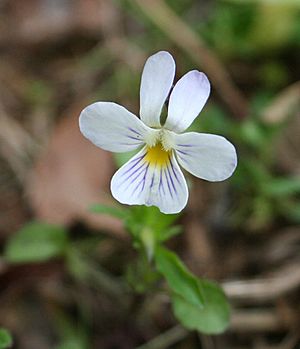Viola bicolor facts for kids
Quick facts for kids Viola bicolor |
|
|---|---|
 |
|
| A light morph of Viola bicolor growing in a sandy field along the mouth of the James River in southeastern Virginia | |
| Conservation status | |
| Scientific classification | |
| Genus: |
Viola (plant)
|
| Species: |
bicolor
|
| Synonyms | |
|
|
The Viola bicolor, also called the American field pansy or wild pansy, is a small plant that lives for only one year. It belongs to the violet family. You can find this plant in many parts of North America.
For a while, people wondered if this plant was originally from North America or if it came from other parts of the world, like Europe. But now, most scientists believe it is a native plant to North America. It often grows in places where the ground has been disturbed, like along roadsides or in empty lots. You can also spot it in open fields and forests. It's not picky about soil and can grow in sandy ground, clay, or even rocky limestone areas.
Contents
What is the American Field Pansy?
The American field pansy is a type of pansy or violet plant. It's known for its small, colorful flowers. These flowers often have two colors, which is why it's called "bicolor" (bi means two, color means color!). The plant usually grows to be about 4 to 12 inches (10 to 30 cm) tall.
What Does It Look Like?
The flowers of the American field pansy are usually small, about 0.2 to 0.6 inches (5 to 15 mm) wide. They can be white, cream, yellow, or a mix of these colors. Often, the two upper petals are a different color from the three lower petals. The lower petals sometimes have purple lines or a small yellow spot.
The leaves of the plant are usually oval or heart-shaped. They grow from the base of the plant and also along the stem. The stems are thin and can be upright or spread out along the ground.
Where Does It Grow?
This plant is very adaptable. It likes sunny spots but can also grow in partial shade. It's common in many different places across North America.
Common Habitats
- Disturbed areas: These are places where the ground has been moved or changed, like construction sites, gardens, or fields that have been plowed.
- Open fields: Large, grassy areas where there aren't many trees.
- Open woods: Forests where the trees are spaced out, allowing sunlight to reach the ground.
- Different soils: It can grow in sandy soil, which is loose and drains quickly. It also grows in clay soil, which is heavy and holds water. And it can even grow in limestone areas, which have rocky soil.
Life Cycle of the American Field Pansy
Since the American field pansy is an annual plant, it completes its entire life cycle in one year.
How It Grows
- Germination: The plant starts from a seed in the spring.
- Growth: It quickly grows stems and leaves.
- Flowering: It produces its small, colorful flowers, usually from spring to early summer.
- Seed Production: After flowering, the plant makes new seeds.
- Death: Once the seeds are mature, the parent plant dies. The new seeds will then wait to grow the next spring. This cycle helps the plant spread and grow in new places each year.


